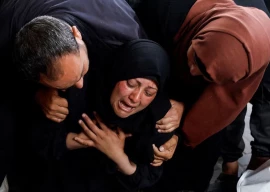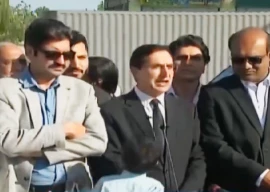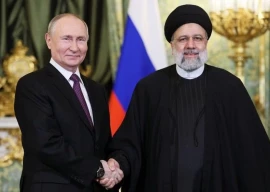Pakistani Prime Minister Nawaz Sharif’s visit to India, while perhaps, inevitable, given the invitation extended to him by the new prime minister of India, did not really break new ground. In fact, by the time the rather tense visiting prime minister left, the bonhomie of the first day when he attended Indian Prime Minister Narendra Modi’s oath-taking ceremony, had been overtaken by the clear reluctance of the Indian side to commit beyond a ‘perhaps’, thereby leaving the state of bilateral relations almost as these were before.
Of course, it can be argued that one visit cannot fling open doors, but then the Indian focus remained on terrorism while Nawaz was not able to really go beyond generalities in the brief statement he read out to the media and left for the airport without taking questions. A scheduled press conference never did happen.
This is in marked contrast to the fast moving relations with China, with both countries moving within hours towards high-level visits, people-to-people interactions, with Beijing in particular discarding its customary cautious approach to embrace Prime Minister Narendra Modi.
Chinese premier Li Keqiang was amongst the first to congratulate Modi on his victory. And within a couple of days followed it with a phone call in which he conveyed his government’s desire to establish a “robust partnership with the new government for further development of relations between the two nations”. Modi himself said that China was a priority in India’s foreign policy and that he wanted to work closely with Beijing on all issues, including border issues and economic development.
Unlike as it was in the past, when Beijing preferred to watch and wait from the sidelines, this time the attitude is not just positive but positively aggressive in forging new ties. It seems as if the Chinese leadership has got wind of Modi’s disinclination to rush towards Washington, given the visa ban imposed by the US on him, and is moving ahead at full speed.
Of course, as all know, there is always many a slip betwixt the cup and the lip, and more so when India’s relations with countries like Pakistan and China are concerned. It was not so long ago that the Indian media was up in arms about the reported Chinese intrusions into Indian territory, with the same news channels who are celebrating the new steps forward, virtually calling for action in the strident tones that have become peculiar to South Asian media these days.
The significance thus lies, for the moment at least, in not what happens next but the new government’s priorities in foreign policy. Afghanistan is one clear such area, with the vigorous handshake between Afghan President Hamid Karzai and Prime Minister Modi at variance with the stiffer Nawaz-Modi meeting. This despite the fact that Karzai is on his way out and Afghanistan will soon have a new president. India and Afghanistan found a meeting ground on terrorism with doors opening for closer cooperation at different levels.
China is clearly a top priority. In fact, India is saying less than China at the moment with Chinese experts hastening to embrace the emerging relationship, and articles in the media there speaking effusively of the shared ‘dreams’ of the two countries. This is a sequel, one must recall, to Modi’s four-day visit to China when he was just the chief minister of Gujarat as a counter to the US refusal to grant him a visa. The red carpet was rolled out for him during that visit and courtesies normally reserved for heads of government extended to him.
But then, long-term relations are not just about the red carpet and courtesy. It remains to be seen how the sum and substance of a complex relationship like this pans out over the months. However, the one positive indicator that there might be a difference in this beginning, as compared to others in the past, is the aggressively friendly approach that Beijing has adopted.
China’s envoy to India, Wei Wei, for instance, wrote an article in a newspaper here saying that both governments “are able and wise enough” to maintain “peace and tranquillity in the border areas” as he identified international platforms for both to work together on.
Published in The Express Tribune, May 31st, 2014.
Like Opinion & Editorial on Facebook, follow @ETOpEd on Twitter to receive all updates on all our daily pieces.
COMMENTS (15)
Comments are moderated and generally will be posted if they are on-topic and not abusive.
For more information, please see our Comments FAQ





















1713281138-0/US-Treasury-Secretary-Janet-Yellen-(2)1713281138-0-270x192.webp)






















Madam Seema Mustafa is a brilliant writer and has the talent and the ability as well to grasp the situation about the developing moments of History. Her article has laid out the developments in India and the coming relation building exercise for Mr Modi whose major problem is to manage the deterioating domestic situation and the dwindling economic growth. On the international level there are indications that the 3rd WW conflict is very likely to start in Asia, now that both India and Japan encouraged by the USA and backed up by relatively smaller countries including vietnam and phillipines, are preparing to challenge China's further expansion in energy areas to maintain its jigantic growth. .
Rex Minor
@Newbie: (1947 Muslim Parliamentarian MC Chagai(hope the spelling is write) spoke for it too) His name was Mahommedali Currim Chagla. A brilliant lawyer & kinsman of Jinnah, Chagla was his junior & an acolyte but broke with him on the issue of Partition. There was no Parliament, as we know, in 1947. First Lok Sabha wa in 1952. Besides, he was a judge then & in '48 he became Chief Justice of Bombay High Court. Later, India's ambassador to US, then education minister & foreign minister. But yes it was very much like him to have supported UCC. Ques:Why all those that talk didn't even try to make a rough-draft of it?
@Naeem Khan Manhattan,Ks: If China is going to persuade anyone in the future, it is going to be Pakistan. Remember, they have been advising you since 1960's- 1st to correct your behavior with respect to East Pakistan, then other things but you guys didn't listen to them even as you refer to them as your mai-bap.
@H Khan: giving you a recommend because your post is very funny.
@H Khan: China’s first true love is Pakistan.
You have tough competition from North Korea. Moreover both of you believe in "Songun" policy.
Nothing happens by chance. The author seems slightly bewildered by Chinese "footsies". What exactly is motivating the Chinese to improve ties with India? The answer primarily lies in the South China Sea region. It is here that 1) China seeks total domination and control over its wealth, 2) Keep the USA out of this region and 3) by keeping the USA out, keep its proxy, Japan, down. China wants to keep its Eastern borders tranquil even as the Sinjiang simmers while it can devote its energies to South China Sea. Additionally it will try to preempt Japan's attempt to carve out a bigger slice for itself int he Indian economic pie. In the coming days Japan will send out even bigger feelers to India. Its market are currently saturated(West) or curtailed(China). India, if it can get its act together, presents a new opportunity. For the Indians this opens many doors. It can astutely use Japanese money and technology to feed the soaring ambitions of its populace, while at the same time deal with the dragon to ensure that in return for a peaceful China border, China should use its influence on its Pakistani ally to rein in its non-state actors for an equally peaceful western border.
@H Khan:
Pakistan is the Chandramukhi to China's Devdas!
For some odd reason this did not read as a ......usual Seema Mustafa read but it read well. Both China and India are looking at economic co-operation.....and why not. Yet it would be naive to think that big powers do not harbour other ambitions.
Never count your chicken before they have hatched. Considering India is one of the few countries which looks at America and Americans in a favorable light, to say relations have been bungled is an understatement. This bungling has also provided an opportunities to the more enterprising countries to step in and speedily fill the void. China is free of ideological baggage and like strong leaders who can keep their promise and deliver, in Modi they see a mirror image of themselves. That they will not be lectured on Human Rights,is a big positive. The Chinese are likely to be the fastest to bag a few choice contracts, much to the consternation of the US and Europeans. This will cause the Asia pivot to spin like a Top. Further speculation is unwise.
It should be appreciated by Pakistanis that China and India are getting closer politically and want to increase bilateral trade, actualy it may help Pakistan in the long run, China may become closer friend and influence the Indians to settle the thorny issues between them and Pakistanis. Good relationship and peaceful co-existance between the neighbor always bring prosperity and harmony. As far as Karzai's cordial reception and departure is concerned, the world knows who Karzai is and who put him there, it was not India or Afghan people or even Pakistan for sure, the future leadership has to tread very carefully and if goes too far in placating the Indians , it will definitely invite trouble for them which they are not ready to encounter. It will be good for the sack of Afghanistan that all neighbors, Pakistan,Iran and India come together for the betterment and peace in Afghanistan. Indians leadership should keep in mind that a super power US could not subjugate certain people of Afghanistan even after 13 years, how could India try to play it's destabilizing game by counter-balancing Pakistan. India has no room to be talking about terrorism because the Pakistanis well know who is doing what in Baluchistan and Pakistan itself is bearing the brunt of this internal and external terrorism.
@Raj - USA: Had no idea. You living in Poona which has drifted next to USA. Who knows Bombay might drift next to Mexico.
When it is Monday morning here in USA, it is already Tuesday in China. They know what is going to happen ahead of USA. No wonder they invented the "fortune cookies".
This is just a facade. China's first true love is Pakistan. Modi's just like the attractive girl who's moved in next door and has caused a temporary distraction. China's doing this to make us feel like jealous wives. Don't worry, we know that eventually you will come back to us :)
Chinese are smart people and they know who matters the most. Indo-Pak relations will remain hostage to Tow Nation Theory for ever and nothing will change on ground. America id suffering from policy paralysis at capital hill. For Americans its like " Karwan Guzar gaya aur gubar dekhte rahe". Modi is not going to waste time as he has to show results. Its all about development and therefore Modi will be interacting more and more with China, Japan and South Korea. With America and Europe it will be business as usual. With Pakistan it will be just engagement and nothing else. Modi knows it fully well that the time invested in Pakistan is not going to bring any major results. In all probability Modi will make his first trip to Japan and China together.